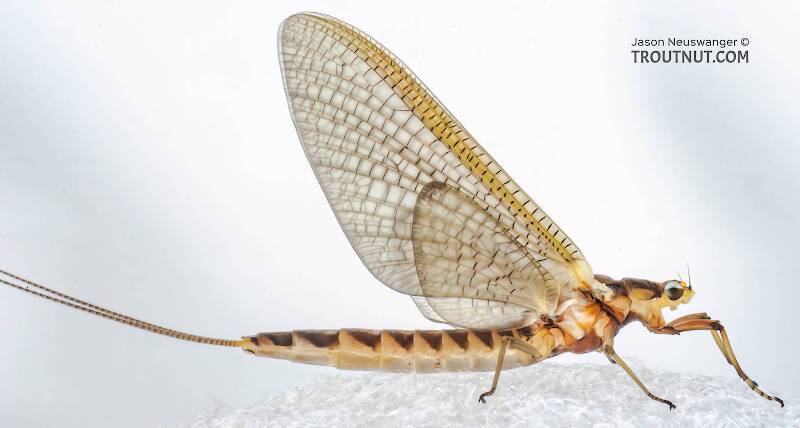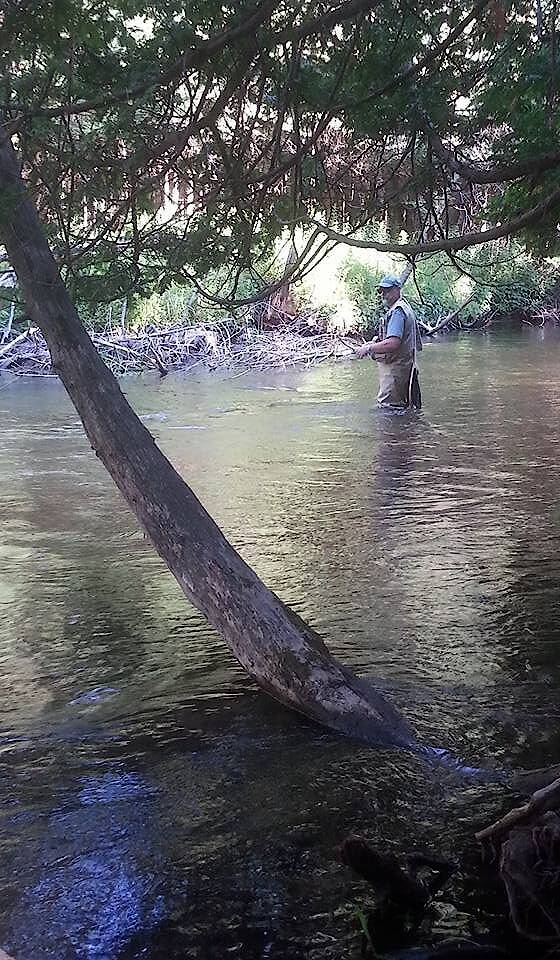
Blue-winged Olives
Baetis
Tiny Baetis mayflies are perhaps the most commonly encountered and imitated by anglers on all American trout streams due to their great abundance, widespread distribution, and trout-friendly emergence habits.
Featured on the forum

With a bit of help from the microscope, this specimen keys clearly and unsurprisingly to Hydropsyche.

Troutnut is a project started in 2003 by salmonid ecologist Jason "Troutnut" Neuswanger to help anglers and
fly tyers unabashedly embrace the entomological side of the sport. Learn more about Troutnut or
support the project for an enhanced experience here.
Waxsmith on Feb 9, 2015February 9th, 2015, 5:19 am EST
Looking at the above pics of hexagenia duns and having seen millions of them on the water live, it strikes me again and again that the great majority of all the mayfly type duns sit there (perhaps not long)not with their wings spread but with them resting upright against each other. The Brit Oliver Edwards acknowledges this in his "cut-wing dun" pattern stating that it is a very sturdy fly which also cuts down on the nasty propellering habits of the partially spread wing tied dun pattern. So why is the traditional dun wing tying position so strongly adhered to?
Jason's hexagenia dun photos are excellent examples, also see Oliver Edwards' "FLYTYERS MASTERCLASS".
Jason's hexagenia dun photos are excellent examples, also see Oliver Edwards' "FLYTYERS MASTERCLASS".
What is this supposed to look like, example please.
TNEAL on Feb 9, 2015February 9th, 2015, 7:02 am EST
Old habits die hard. 60 years later I still use barrel knots and clinch knots.
Roguerat on Feb 9, 2015February 9th, 2015, 7:23 am EST
There are a lot of patterns that use a single-wing profile....Thorax-types, Harrop's Hair-wing-duns to name just a couple. I refer (often!) to an article in the Sept/Oct '95 issue of American Angler, 'One Wing Duns' by Art Scheck, which gives an attractive, sturdy, and simple tie for the titled fly.
Truthfully I've rarely tied Adirondack-style flies; they're elegant, historic, and catch trout like crazy but the split-wing thing puzzled me. No difficulty in tying them, just why split the wings and even cant them forward a bit...?
Tim- it's time you advanced to the IMPROVED clinch knot! I should talk, I use the Trilene knot a lot!
Roguerat
Truthfully I've rarely tied Adirondack-style flies; they're elegant, historic, and catch trout like crazy but the split-wing thing puzzled me. No difficulty in tying them, just why split the wings and even cant them forward a bit...?
Tim- it's time you advanced to the IMPROVED clinch knot! I should talk, I use the Trilene knot a lot!
Roguerat
Roguerat on Feb 9, 2015February 9th, 2015, 7:27 am EST
I need to correct myself, I named 'Adirondack' instead of Catskill flies.
oops.
Roguerat
oops.
Roguerat
Wbranch on Feb 9, 2015February 9th, 2015, 8:34 am EST
I think out of my 5000 or so dry flies there are two divided wing Quill Gordons and I bought those about twenty years ago. I prefer the single wing approach and have used deer and elk hair, CDC, Woodduck, turkey flats, and floating poly yarn for my single upright wings.
Catskill fly fisher for fifty-five years.
Martinlf on Feb 9, 2015February 9th, 2015, 8:35 am EST
When mayflies emerge, their wings show a split before they extend and dry. Mayflies may also wave their wings before getting airborne. I tie a few split wing fly styles because they seem to work at times when others don't. But who knows exactly what the trout sees in split wing flies, given variations of hackle density and placement, much less what a trout may think about what it sees. I do know this; trout eat these flies.
As for knots, the Trilene is generally considered stronger than the improved clinch. If you want a really fast strong knot, try the double Davy.
As for knots, the Trilene is generally considered stronger than the improved clinch. If you want a really fast strong knot, try the double Davy.
"He spread them a yard and a half. 'And every one that got away is this big.'"
--Fred Chappell
--Fred Chappell
Roguerat on Feb 9, 2015February 9th, 2015, 9:30 am EST
I'll risk my wife's ire and practice the double Davy knot then, best done in a recliner while watching the boob-tube and burning through an old spool of Stren or something left from my bait-casting days...the mono clippings seem to find their way into the vacuum, the dogs' paws, and other places they shouldn't be...just like the hair and feather bits under my tying table.
Quick Reply
Related Discussions
Topic
Replies
Last Reply
25
Aug 18, 2011
by Sayfu
by Sayfu





